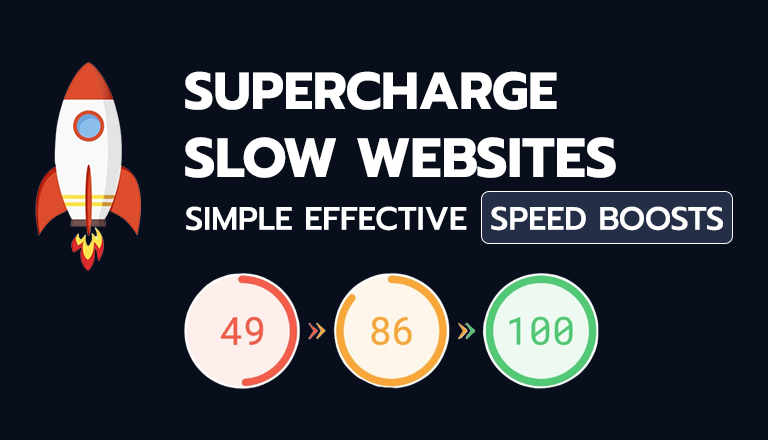In the fast-paced digital world, website speed is not just a convenience; it’s a necessity for small businesses.
The performance of your website can significantly impact user experience, influencing customer satisfaction, retention, and ultimately, your business’s bottom line. Moreover, website speed is a critical factor in search engine optimization (SEO), affecting your site’s visibility and ranking.
This comprehensive guide will walk you through the importance of website speed and performance for small businesses, offering practical tips and insights on how to enhance it. Whether you’re running an e-commerce platform or a local service website, understanding and improving your website’s speed can set you apart in a competitive online marketplace.
Understanding Website Speed and Performance
Website speed refers to how quickly a website loads and becomes interactive for users. It’s an amalgamation of various factors, including server response time, file sizes, and website coding efficiency.
Fast websites are key to keeping users engaged. They lead to more page views and lower bounce rates. Studies indicate that even a one-second delay in page load time can notably decrease page views, customer satisfaction, and conversion rates. Websites that load quickly tend to retain visitors better and have higher conversion rates compared to slower sites.
Additionally, search engines like Google favor faster websites in their rankings, viewing speed as a crucial aspect of user experience. By enhancing your website’s speed, you not only improve user experience but also boost your search engine visibility, potentially leading to increased organic traffic.
Key Factors Affecting Website Speed
Identifying what slows down your website is the first step towards improving its performance. Here are some common speed bottlenecks and the role of web hosting in website performance.
Identifying Common Speed Bottlenecks
Large, high-resolution images and media files can greatly slow down page load times, making it essential to optimize these files to speed up your website.
Similarly, bulky code, unnecessary scripts, and inefficient CSS or JavaScript can also hinder your site’s performance.
By addressing both media file sizes and coding efficiency, you can significantly improve your website’s speed and user experience.
The Role of Web Hosting in Performance
Your hosting provider plays a crucial role in your website’s speed and reliability. Opt for a host that offers fast server response times and robust infrastructure.
Shared hosting, while cost-effective, might not offer the best performance for high-traffic sites. Consider upgrading to VPS or dedicated hosting for better speed and resource allocation.
Practical Tips to Enhance Website Speed
Optimizing your small business website for speed is not just about enhancing user experience; it’s about securing a competitive edge. Here are some effective ways to ramp up your website’s performance.
Optimizing Images and Media Content
1. Image Compression and Format Selection
Compressing images is a crucial step to reduce file size while maintaining quality, enhancing your website’s performance. You can use tools like Adobe Photoshop or free online compressors like Tinypng for this purpose.
Additionally, selecting the appropriate image format is important: JPEG is ideal for photographs, PNG suits graphics with fewer colors, and WebP offers a good balance between quality and performance.
2. Using Video Hosting Platforms for Better Performance
To optimize your website’s performance, consider hosting videos on platforms like YouTube or Vimeo and then embedding them on your site. This approach saves bandwidth and improves load times.
Additionally, avoid setting videos to auto-play, as this can significantly reduce the demands on initial page load, further enhancing the speed and user experience of your site.
Streamlining Website Code
3. Minifying CSS, JavaScript, and HTML
4. Implementing Caching Techniques
Browser caching is a technique where parts of your website are stored on visitors’ devices, which means that on subsequent visits, your site will load faster. This is because the browser doesn’t need to reload the entire page from scratch every time.
To implement this effectively, you can use caching plugins like WPRocket or LiteSpeed Cache or take advantage of settings offered by your web hosting service.
Effective caching strategies not only improve the speed of your website for returning visitors but also enhance the overall user experience by providing quicker access to your site’s content.
Leveraging Tools and Technologies for Speed Optimization
Utilizing the right tools and technologies is essential for effectively optimizing your small business website’s speed. Let’s explore essential tools for analysis and advanced techniques for performance improvement.
Essential Tools for Website Speed Analysis
Google PageSpeed Insights and GTmetrix are popular tools that provide insights into your website’s performance and offer recommendations for improvement. They analyze various aspects like server response time, image optimization, and script loading times.
Understand the metrics these tools provide, such as load time, page size, and the number of requests. You should then priortize the suggested improvements based on their potential impact on your website’s performance.
Using Content Delivery Networks (CDNs)
Content Delivery Networks (CDNs) work by distributing your website’s content across a network of servers around the world. This setup significantly reduces the distance between your users and the servers, leading to improved load times.
CDNs are exceptionally beneficial for websites that cater to a global audience or those that feature heavy media content. By storing your website’s content closer to your users geographically, CDNs ensure faster access and smoother loading of your site, regardless of where your users are located.
This is particularly important for sites with large images, videos, or other media-rich content, as it enhances the user experience by providing quick and efficient content delivery.
Implementing Accelerated Mobile Pages (AMP)
AMP, or Accelerated Mobile Pages, is a project backed by Google, specifically developed to speed up web page loading on mobile devices. By simplifying HTML and adhering to strict configuration guidelines, AMP optimizes web pages to load much faster on mobile platforms. This approach strips down the code and reduces complexity, which not only enhances the speed but also improves the overall user experience on smartphones and tablets.
Implementing AMP can be particularly beneficial for websites with a significant mobile user base, as it ensures that content is delivered quickly and efficiently, keeping mobile users engaged and reducing bounce rates due to slow loading times.
Regular Maintenance for Ongoing Performance
Consistent and regular maintenance is crucial for sustaining the performance of your small business website. It ensures that your site remains fast, reliable, and efficient over time.
Scheduling Regular Website Audits
Monitoring and Responding to Performance Metrics
When setting up performance monitoring for your website, it’s a good idea to use tools like Google Analytics and Jetpack. These help you keep a continuous check on how your site’s doing.
Make sure to set up alerts so you’re notified if there’s a big drop in performance or any uptime issues. If your website starts slowing down, you want to jump on that quickly by investigating what’s causing the speed dip and fix it.
Also, remember that web standards and tech are always changing, so keep updating your optimization strategies to stay on top of things.
Wrapping Up
For small businesses, website speed is not just a technical metric; it’s a critical factor that influences user experience, customer satisfaction, and overall online success. A fast, responsive website can significantly elevate your brand’s digital presence.
Regularly monitoring and enhancing your website’s speed should be an integral part of your digital strategy. Continuous improvement in this area leads to better user engagement, higher search rankings, and, ultimately, business growth.
Comprehensive FAQ Section
This section aims to address frequently asked questions about website speed and maintenance, providing key insights for small business owners.
- How can I effectively optimize images for faster loading?
Use image compression tools, choose appropriate file formats (like JPEG for photos, PNG for graphics), and consider responsive images that adjust to screen size. - What role does web hosting play in website speed?
Your hosting provider significantly impacts site speed, with factors like server location, resource allocation, and technology playing crucial roles. Upgrading to a higher-tier hosting plan can improve performance. - How do website speed analysis tools work and which should I use?
Tools like Google PageSpeed Insights analyze your website’s content and structure, providing scores and recommendations for improvement. GTmetrix and Pingdom are also popular choices. - What are CDNs and how do they improve website speed?
Content Delivery Networks (CDNs) distribute your website content across multiple, geographically dispersed servers, reducing the distance data travels to reach users and thereby speeding up load times. - How often should I conduct website speed audits?
Regular audits, at least quarterly, are recommended to identify and rectify issues that may affect your website’s performance. - Can website speed affect my business’s search engine rankings?
Yes, website speed is a crucial SEO factor. Faster websites are favored by search engines, leading to better rankings and increased visibility. - Is mobile optimization important for website speed?
Absolutely. With the increasing use of mobile devices, ensuring your website loads quickly and efficiently on mobile is critical for user experience and SEO. - What immediate actions can improve website speed?
Start by optimizing images, minifying CSS and JavaScript files, implementing browser caching, and evaluating your hosting plan.






Share Your Thoughts: